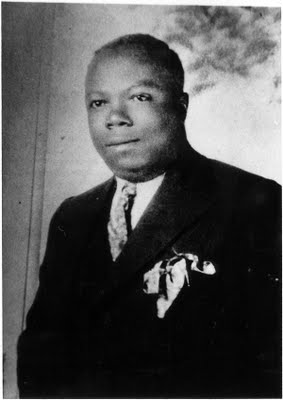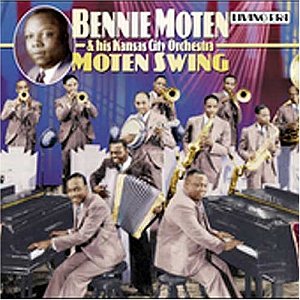Related Research Articles
Jazz is a music genre that originated in the African-American communities of New Orleans, Louisiana, in the late 19th and early 20th centuries, with its roots in blues, ragtime, European harmony and African rhythmic rituals. Since the 1920s Jazz Age, it has been recognized as a major form of musical expression in traditional and popular music. Jazz is characterized by swing and blue notes, complex chords, call and response vocals, polyrhythms and improvisation.

A big band or jazz orchestra is a type of musical ensemble of jazz music that usually consists of ten or more musicians with four sections: saxophones, trumpets, trombones, and a rhythm section. Big bands originated during the early 1910s and dominated jazz in the early 1940s when swing was most popular. The term "big band" is also used to describe a genre of music, although this was not the only style of music played by big bands.

William James "Count" Basie was an American jazz pianist, organist, bandleader, and composer. In 1935, he formed the Count Basie Orchestra, and in 1936 took them to Chicago for a long engagement and their first recording. He led the group for almost 50 years, creating innovations like the use of two "split" tenor saxophones, emphasizing the rhythm section, riffing with a big band, using arrangers to broaden their sound, his minimalist piano style, and others.
Swing music is a style of jazz that developed in the United States during the late 1920s and early 1930s. It became nationally popular from the mid-1930s. Swing bands usually featured soloists who would improvise on the melody over the arrangement. The danceable swing style of big bands and bandleaders such as Benny Goodman was the dominant form of American popular music from 1935 to 1946, known as the swing era, when people were dancing the Lindy Hop. The verb "to swing" is also used as a term of praise for playing that has a strong groove or drive. Musicians of the swing era include Duke Ellington, Benny Goodman, Count Basie, Cab Calloway, Benny Carter, Jimmy Dorsey, Tommy Dorsey, Woody Herman, Earl Hines, Bunny Berigan, Harry James, Lionel Hampton, Glenn Miller, Artie Shaw, Jimmie Lunceford, and Django Reinhardt.

Andrew Dewey Kirk was an American jazz bandleader and saxophonist who led the Twelve Clouds of Joy, a band popular during the swing era.
Charles Phillip Thompson was an American swing and bebop pianist, organist, composer, and arranger.

Benjamin Moten was an American jazz pianist and band leader born and raised in Kansas City, Missouri, United States.
Walter Sylvester Page was an American jazz multi-instrumentalist and bandleader, best known for his groundbreaking work as a double bass player with Walter Page's Blue Devils and the Count Basie Orchestra.

Kansas City jazz is a style of jazz that developed in Kansas City, Missouri during the 1920s and 1930s, which marked the transition from the structured big band style to the much more improvisational style of bebop. The hard-swinging, bluesy transition style is bracketed by Count Basie, who in 1929 signed with Bennie Moten's Kansas City Orchestra, and Kansas City native Charlie Parker, who promoted the bebop style in America.
A "Kansas City Shuffle" is an advanced form of a bait-and-switch confidence game employing misdirection, deception, and playing on the "mark's" arrogance or self-loathing. It is also the title of a 1926 jazz song named after the scheme.

Harlan Leonard was an American jazz bandleader and clarinetist from Kansas City, Missouri, United States.

"Twelfth Street Rag" is a ragtime musical composition published by Euday L. Bowman in 1914.
Edward Durham was an American jazz guitarist, trombonist, composer, and arranger. He was one of the pioneers of the electric guitar in jazz. The orchestras of Bennie Moten, Jimmie Lunceford, Count Basie, and Glenn Miller took great benefit from his composing and arranging skill.
"South" is a jazz composition by Thamon Hayes and Bennie Moten. It was introduced by Bennie Moten's Kansas City Orchestra in 1924 and recorded again in 1928, when it became a national hit. It was Moten's most popular composition.
Ronald "Jack" Washington was an American jazz saxophonist who was a member of the Count Basie orchestra in the 1930s and 1940s.
"Baby Dear" is a Dixieland tune composed by Thamon Hayes & Benny Moten. It was first recorded by Bennie Moten with the Kansas City Orchestra for Okeh Records in 1924, and later by Mary Lou Williams and her Kansas City Seven. Both records are available on YouTube:

"Moten Swing" is a 1932 jazz standard by Bennie Moten and his Kansas City Orchestra. It was an important jazz standard in the move towards a freer form of orchestral jazz and the development of Swing music. Moten and his Orchestra, which included Count Basie on piano, achieved much success with it, although the song is most associated with Basie's Count Basie Orchestra, who recorded it in 1940.
The Golden Gate Ballroom, originally named the "State Palace Ballroom", was a luxurious ballroom located at the intersection of Lenox Avenue and 142nd Street in Harlem in New York City. It was allegedly the largest public auditorium in Harlem, with 25,000 square feet and a capacity of about 5,000 people on the dance floor in addition to several thousand spectators.
Paul Banks was an American jazz pianist, bandleader, composer and lyricist.
References
- ↑ "Thamon Hayes". Missouri Death Decords. Retrieved 6 December 2013.
- ↑ Russell, Ross (1983). Jazz Style in Kansas City and the Southwest. University of California Press. p. 11. ISBN 978-0-520-04785-3.
- ↑ "Thamon Hayes". Discogs. Retrieved 6 December 2013.
- ↑ Schuller, Gunther (2 March 1989). The Swing Era: The Development of Jazz, 1930-1945. Oxford University Press. p. 48. ISBN 978-0-19-987934-2.
- ↑ Driggs, Frank (1 May 2005). Kansas City Jazz : From Ragtime to Bebop--A History: From Ragtime to Bebop--A History . Oxford University Press. p. 110. ISBN 978-0-19-536435-4.